Curdled white remnants of milk coming out of baby’s nose & mouth. Sour in odour it resembles split milk. Should you worry? Is this vomit? Is the baby unable to hold the milk in its tummy? Should I see a doctor? Am I doing something wrong? Like you, I faced the dilemma in the early months of raising my son, Kabir. We had noticed minor spit ups while he was on breast milk, but on adding a feed of formula milk, the spit ups increased. Kabir’s discomfort while the spit up was also evident. We spoke to our doctor and researched about newborn spit up to understand more about it. This also happened to be one of the most common query posted to us, that we come across while reading the feedbacks. To be upfront with you, spit ups are absolutely normal.
A newborn baby is yet to form a strong digestive system. Spit ups are more frequent amongst newborn. About 99% newborn’s spit up often. This reduces as the baby grows up. 50% babies have it for the first 6 months and 5-10%babies continue to have spit ups up to 1 year. These facts alone should be able to calm your anxiety. Going deeper into understanding this occurrence, let me address your concerns-
Why does spit up happen?
Spit up is partially digested milk, that appears to be of a curdled-milk/paneer like texture. It can happen anytime, even after burping. If the baby has had too much of milk or engaged in a lot of movement after drinking milk, the chances of a spit up are more. This tends to reduce as the baby grows up and its digestive system matures.
When does it stop?
As mentioned above, the digestive system needs time to be able to assimilate the milk that a baby drinks. By the time the baby starts sitting up, the digestive system is stronger. Hence, there is a significant reduction of spit ups by the 6th month and gradually it disappears completely.
What does one do when spilt ups happen?
Being a normal part of growing up, all that a parent can do is clean it up. Along with it, hold the baby upright and try not to have a lot of movement, for at least 20 mins after the feed. Instead of feeding a lot to the baby at one time, switch to small and regular feeds. A 2-3 hrs gap in between is fine. This would reduce any extra pressures on the baby’s tummy. If your baby is on formula, try switching the brand. Sometimes spit ups can be due to an inability to adapt to a particular brand of formula. Burping is a must after every feed. Your baby might not burp at times, yet it is important to try to burp it. It would be best to observe and write down when the spit ups happen. This would help you find a pattern for its occurrence. Eg- If you notice that the spit ups are due to movements and activities right after a feed, try and limit the cause.
When do I need to worry about the newborn spit up?
You need to seek medical guidance if:
a) The baby’s weight is dropping or is at a constant- A baby’s weight should increase in its first year. By 6 months, a baby should be double its birth weight and by a year, the weight should be in the 10-12 kgs bracket. However, if it is not, a thorough examination by the doctor is recommended.
b) The baby shows signs of discomfort while spit up- Cramps or acute discomfort right before a spit up, needs to be addressed. As with our son Kabir, he looked in pain before spit up. We observed it after we introduced him to NAN PRO. Switching to Enfamil reduced the occurrence. On introducing Similac, spit ups were no longer painful and had reduced in frequency. This meant that the first brand didn’t suit him well. Since every baby is different, it’s best to seek council of a doctor, in case your baby suffers from the same.
c) The baby is feeding less- This is a red flag. A baby should be consuming more milk as it grows. Visit a doctor if there is a reduction in the feed.
d) The baby is vomiting- A spit up is not a vomit. On seeing the consistency and quantity, one can easily determine whether it’s a vomit or a spit up. If the baby is vomiting out the milk, it might be signs of an infection.
As a baby grows, there would be changes. The moment one assumes that they have figured out the baby’s routine, a new and unexpected developmental hurdle may arrive. MomComIndia has been built with the intent of being a support system to all new parents. The more we interact across our pages on Instagram, Facebook, YouTube, Twitter and our website, it would be easier to find solutions to the challenges of parenting. Sharing the information with other parents would ease their journey as well. Do watch the video content of the topic below and share it with other parents. Together we build a community. Enjoy simplified parenting.
♥♥ बच्चों का उलटी करना (BABY SPIT UP) || क्यों होता है और क्या करना चाहिए? | इस आर्टिकल की जानकारी हिंदी में पाने के लिए नीचे दिए वीडियो को देखें ►







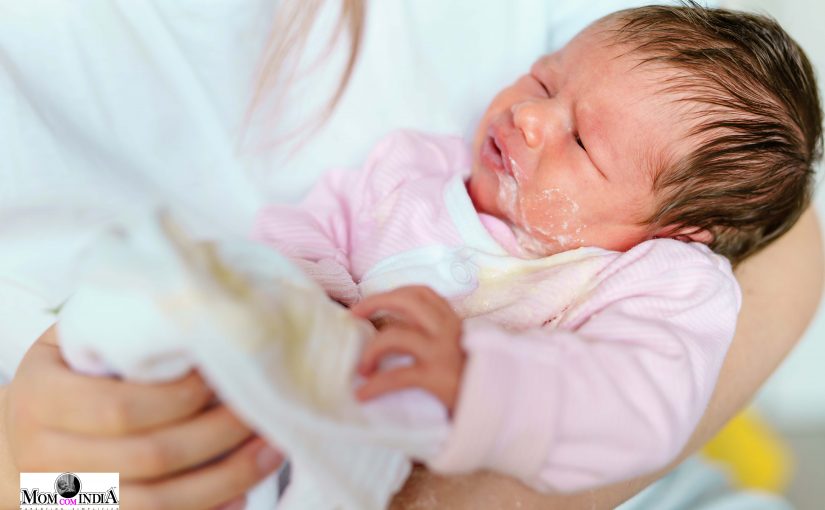
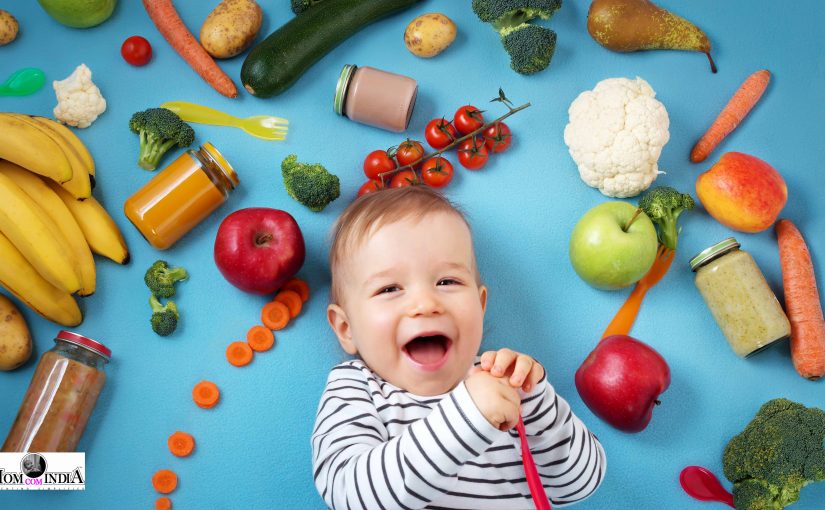
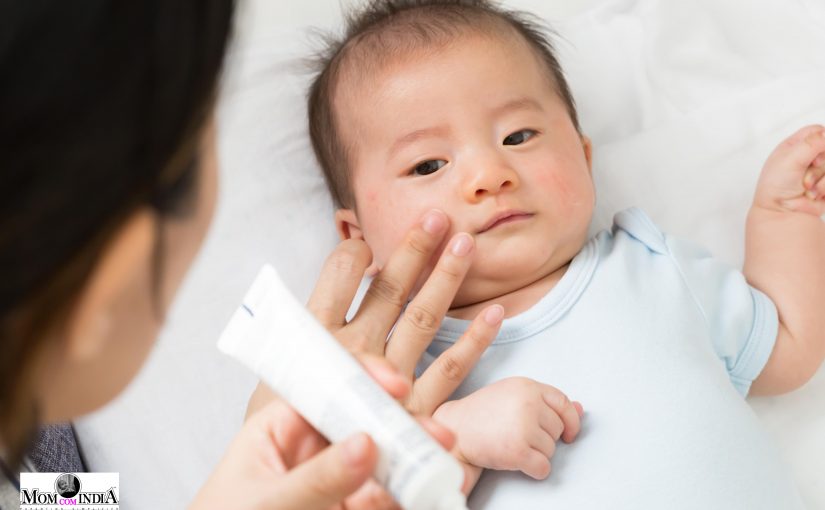
 Setting the misconception aside, the food that we eat during pregnancy provides nutrition to both mother and baby. Eat to be healthy and happy. In that parlance, coconuts, almonds are a wonderful addition to the diet. Healthy skin and hair is directly related to good nutrition. After delivery, the diet of a breast feeding mother provides nourishment to the baby. Any ubtan used on the baby is essentially to remove unwanted hair, dirt or sweat. In fact, a baby’s complexion may change in the first 3-4 months. This is a natural process as the body hair sheds off. If a baby has had jaundice at birth, that too affects it skin colour. However, as the baby recovers, its skin colour returns as per its genetic make. Let the happiness of parenting not be hampered by ill-advised notions.
Setting the misconception aside, the food that we eat during pregnancy provides nutrition to both mother and baby. Eat to be healthy and happy. In that parlance, coconuts, almonds are a wonderful addition to the diet. Healthy skin and hair is directly related to good nutrition. After delivery, the diet of a breast feeding mother provides nourishment to the baby. Any ubtan used on the baby is essentially to remove unwanted hair, dirt or sweat. In fact, a baby’s complexion may change in the first 3-4 months. This is a natural process as the body hair sheds off. If a baby has had jaundice at birth, that too affects it skin colour. However, as the baby recovers, its skin colour returns as per its genetic make. Let the happiness of parenting not be hampered by ill-advised notions. Daily bathing ritual is an important part of skin care. After 15 mins of oil application, a bath with lukewarm water soothes the baby. Dip your elbow in the water to ascertain that the temperature is suitable for baby. There is no need to leave the oil for a longer time or overnight. 15 mins is a good time period for the oil to be absorbed by the skin. Any longer and it could attract dirt and dust, causing irritation to the baby’s skin. For bath you should use a Gentle Baby Body Wash, click here to see our recommendations.
Daily bathing ritual is an important part of skin care. After 15 mins of oil application, a bath with lukewarm water soothes the baby. Dip your elbow in the water to ascertain that the temperature is suitable for baby. There is no need to leave the oil for a longer time or overnight. 15 mins is a good time period for the oil to be absorbed by the skin. Any longer and it could attract dirt and dust, causing irritation to the baby’s skin. For bath you should use a Gentle Baby Body Wash, click here to see our recommendations. It is not enough to moisturise baby skin once a day. Baby skin tends to dehydrate faster. Applying moisturiser 3-4 times is ideal especially in winters. The salient points to remember during moisturising are –
It is not enough to moisturise baby skin once a day. Baby skin tends to dehydrate faster. Applying moisturiser 3-4 times is ideal especially in winters. The salient points to remember during moisturising are – While the routine needs to be followed regularly, using quality products ensures the safety of the baby. There are a lot of baby products in the market, hence reading the label of the products to understand the formulation is important. For our son was born in 2017 the Indian market didn’t have some of the products which are available at the time of writing this article (in 2021). So at that time we chose to invest in international and premium brands. Though they were costlier, we were sure that their formulation is safe for the baby. Since then there are many products which are equally good available in the Indian market.
While the routine needs to be followed regularly, using quality products ensures the safety of the baby. There are a lot of baby products in the market, hence reading the label of the products to understand the formulation is important. For our son was born in 2017 the Indian market didn’t have some of the products which are available at the time of writing this article (in 2021). So at that time we chose to invest in international and premium brands. Though they were costlier, we were sure that their formulation is safe for the baby. Since then there are many products which are equally good available in the Indian market.
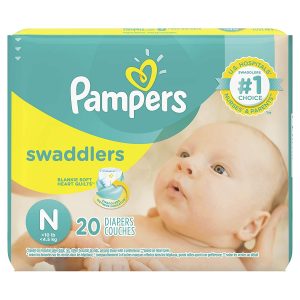 Parents often get confused about which diaper to purchase. To decide we rely on the advice of chemists, commercials or other parents. Avoid cheap diapers, when you purchase a particular brand, do observe its performance, especially its soaking power. A baby should not feel the wetness in a diaper. Since all babies are unique, check whether the brand suits your baby. If not then change the diaper brand. We found both Huggies and Pampers to be good brands to use
Parents often get confused about which diaper to purchase. To decide we rely on the advice of chemists, commercials or other parents. Avoid cheap diapers, when you purchase a particular brand, do observe its performance, especially its soaking power. A baby should not feel the wetness in a diaper. Since all babies are unique, check whether the brand suits your baby. If not then change the diaper brand. We found both Huggies and Pampers to be good brands to use  Depending on the amount of peeing that a baby does, a diaper should be changed every 2-3 hours. Even if the diaper is not full in 3 hours, change it. For poop, a diaper has to be changed immediately. This prevents the growth of germs in the diaper. My son had a phase where he was peeing around 20 times a day. I changed him every 2 hours to maintain the hygiene. Some babies get uncomfortable even after a pee, in such a case one might need to change the diaper every time baby urinates. Analyse your baby’s comfort and maintain a hygienic cycle of diaper change. Remember, when you delay changing a wet diaper the chances of a rash becomes high.
Depending on the amount of peeing that a baby does, a diaper should be changed every 2-3 hours. Even if the diaper is not full in 3 hours, change it. For poop, a diaper has to be changed immediately. This prevents the growth of germs in the diaper. My son had a phase where he was peeing around 20 times a day. I changed him every 2 hours to maintain the hygiene. Some babies get uncomfortable even after a pee, in such a case one might need to change the diaper every time baby urinates. Analyse your baby’s comfort and maintain a hygienic cycle of diaper change. Remember, when you delay changing a wet diaper the chances of a rash becomes high. For the sake of convenience, more parents are choosing baby wipes. While it is a great option, when the baby is having a day out or when one is traveling, it is best to use water to clean a baby at home. During a diaper change wash the bottom with your hands and pat dry with a Bamboo Fabric Washcloth which are great for sensitive skin of baby. Leave it to air dry for 5-10 minutes. Apply a diaper rash cream or coconut oil, before putting on the fresh diaper. For our days out, we used the Pampers Sensitive wipes. Many wipes have alcohol in them which irritates the baby’s skin. Check the labelling and avoid using such wipes. Bamboo Based Organic wipes are great for this purpose.
For the sake of convenience, more parents are choosing baby wipes. While it is a great option, when the baby is having a day out or when one is traveling, it is best to use water to clean a baby at home. During a diaper change wash the bottom with your hands and pat dry with a Bamboo Fabric Washcloth which are great for sensitive skin of baby. Leave it to air dry for 5-10 minutes. Apply a diaper rash cream or coconut oil, before putting on the fresh diaper. For our days out, we used the Pampers Sensitive wipes. Many wipes have alcohol in them which irritates the baby’s skin. Check the labelling and avoid using such wipes. Bamboo Based Organic wipes are great for this purpose.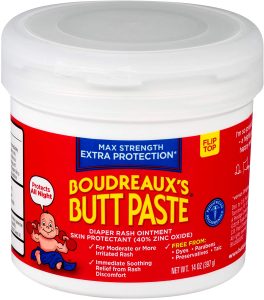 Diaper rash cream is a preventive measure and is to be used regularly. The assumption that diaper rash creams are only for use during a diaper rash is false. With every change apply a diaper rash cream or coconut oil. This creates a protective barrier on the baby’s skin. Invest in a good zinc oxide based diaper rash cream
Diaper rash cream is a preventive measure and is to be used regularly. The assumption that diaper rash creams are only for use during a diaper rash is false. With every change apply a diaper rash cream or coconut oil. This creates a protective barrier on the baby’s skin. Invest in a good zinc oxide based diaper rash cream  The only effective remedy to treat a diaper rash is more contact with air. Leave the baby’s bottom open or make the baby wear loose bottoms. Also avoid using wipes in such cases. The wiping motion aggravates the situation. We had kept separate lowers for Kabir, that he used to wear only during the hours that we left him diaper free. Wash, air dry, apply diaper rash cream and leave the baby diaper free. Do not apply powder as it will only block the pores on baby’s skin, worsening the rash. Do not overlook a diaper rash. It can worsen quickly.
The only effective remedy to treat a diaper rash is more contact with air. Leave the baby’s bottom open or make the baby wear loose bottoms. Also avoid using wipes in such cases. The wiping motion aggravates the situation. We had kept separate lowers for Kabir, that he used to wear only during the hours that we left him diaper free. Wash, air dry, apply diaper rash cream and leave the baby diaper free. Do not apply powder as it will only block the pores on baby’s skin, worsening the rash. Do not overlook a diaper rash. It can worsen quickly.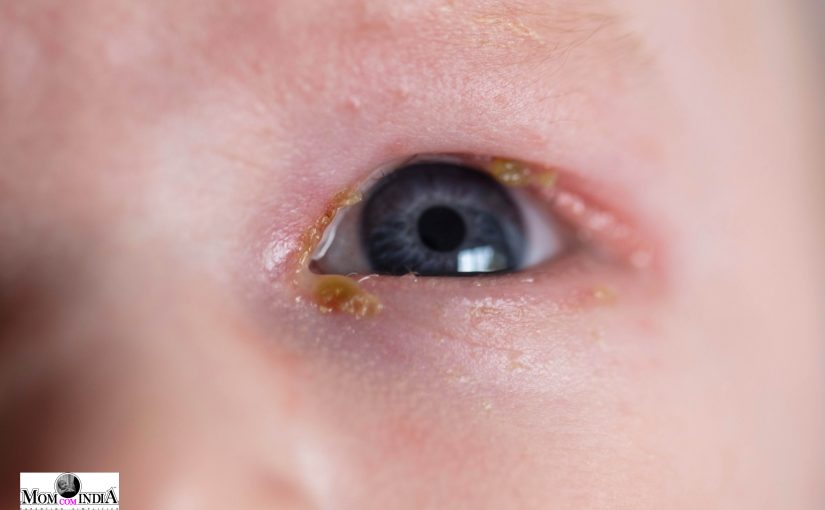
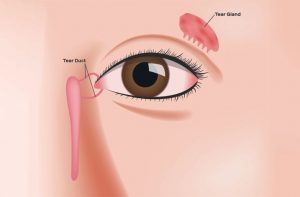 A tear duct is a tube in the inner corner of the eye, that helps in draining tears from the eyes. Though a new born cries often, tears start forming in its glands at around 2-3 weeks from birth. The ducts allow the tears to flow out of the eyes. However, sometimes for a baby the duct is blocked. The tears instead of flowing out, find its way back into the eye, leading to minor infections. This situation can continue till 6 months of age. Though it can be easily resolved at home, in severe cases of infection or if the condition continues for more that 6 months of age, medical procedures might be needed. Luckily in Kabir’s case, it was temporary.
A tear duct is a tube in the inner corner of the eye, that helps in draining tears from the eyes. Though a new born cries often, tears start forming in its glands at around 2-3 weeks from birth. The ducts allow the tears to flow out of the eyes. However, sometimes for a baby the duct is blocked. The tears instead of flowing out, find its way back into the eye, leading to minor infections. This situation can continue till 6 months of age. Though it can be easily resolved at home, in severe cases of infection or if the condition continues for more that 6 months of age, medical procedures might be needed. Luckily in Kabir’s case, it was temporary. To do the massage, take you little finger to the inner most corner of the baby’s eye, at the base of the nose bridge. Gently massage it in a circular motion, and then drag the finger down the sides of the nose. To see the massage, watch our video content linked here. Before massaging the child’s tear duct, I would also ask you to practice it first in front of your doctor. The baby’s eyes are very sensitive and it’s important to understand how much pressure to apply on the ducts. A paediatrician will efficiently guide you through it. Doing this massage for a few times in a day, should resolve the issue in 2-3 days. It is mandatory that you wash your hands well with a soap before massaging the baby. Should the infection in the eye worsen or tear duct continues to be blocked even after 6 months of age, the medical practitioner might advise a minor surgery.
To do the massage, take you little finger to the inner most corner of the baby’s eye, at the base of the nose bridge. Gently massage it in a circular motion, and then drag the finger down the sides of the nose. To see the massage, watch our video content linked here. Before massaging the child’s tear duct, I would also ask you to practice it first in front of your doctor. The baby’s eyes are very sensitive and it’s important to understand how much pressure to apply on the ducts. A paediatrician will efficiently guide you through it. Doing this massage for a few times in a day, should resolve the issue in 2-3 days. It is mandatory that you wash your hands well with a soap before massaging the baby. Should the infection in the eye worsen or tear duct continues to be blocked even after 6 months of age, the medical practitioner might advise a minor surgery.